7 Real UX Designer Resumes and a Template
Here are seven UX designer resumes, from real designers at various stages in their careers, to inspire you, encourage you, and help you learn.
![[Featured image] A UX designer is working from home holding a baby as they type on their laptop.](https://d3njjcbhbojbot.cloudfront.net/api/utilities/v1/imageproxy/https://images.ctfassets.net/wp1lcwdav1p1/58bpNYzagq5zMIrNIGOT2o/4687e0a3a8cae1f615a4ee44326f5058/GettyImages-571492555.jpg?w=1500&h=680&q=60&fit=fill&f=faces&fm=jpg&fl=progressive&auto=format%2Ccompress&dpr=1&w=1000)
Key takeaways
Applying to a job listing with a well-put-together resume is an important step toward landing a UX designer role.
As a UX designer, it’s helpful to include a portfolio as part of your resume to show employers some examples of your work.
It’s generally best to keep your resume concise and try to limit yourself to one page.
You can improve your chances of becoming a UX designer by focusing on acquiring the most essential UX design skills.
Learn how to build a strong UX designer resume to reach your career goals. If you’re ready to start earning valuable credentials that you can feature on your resume, earn a Microsoft UX Design Professional Certificate, where you have the opportunity to gain in-demand skills in areas like Human-Centered Design and complete projects for your portfolio.
UX designer resume examples: From current student to senior designers
The following seven resumes are from designers at various stages in their careers. Though no resume is ever perfect, you can learn a lot by seeing what other people have done before you. Each has several takeaways you can incorporate into your own.
1. Current student

What you can learn:
If you’re a student, emphasize any relevant experience, like internships or relevant extracurriculars, to build out your resume. Look for opportunities on campus to exercise the skills you’ll want to use professionally. Join a student group that will let you use your design skills. You can also approach the leadership of a group you’re already in to see if you can take on any design projects, like designing social media posts or a website. Visit your career center to see if they can connect you with design internships and other opportunities.
As a student, your work experiences might still be limited. Don’t be afraid to put down experiences that didn’t directly involve design. Work or club involvement that shows your passions, or workplace skills like time management, collaboration, or communication, can be beneficial.
2. UX design intern
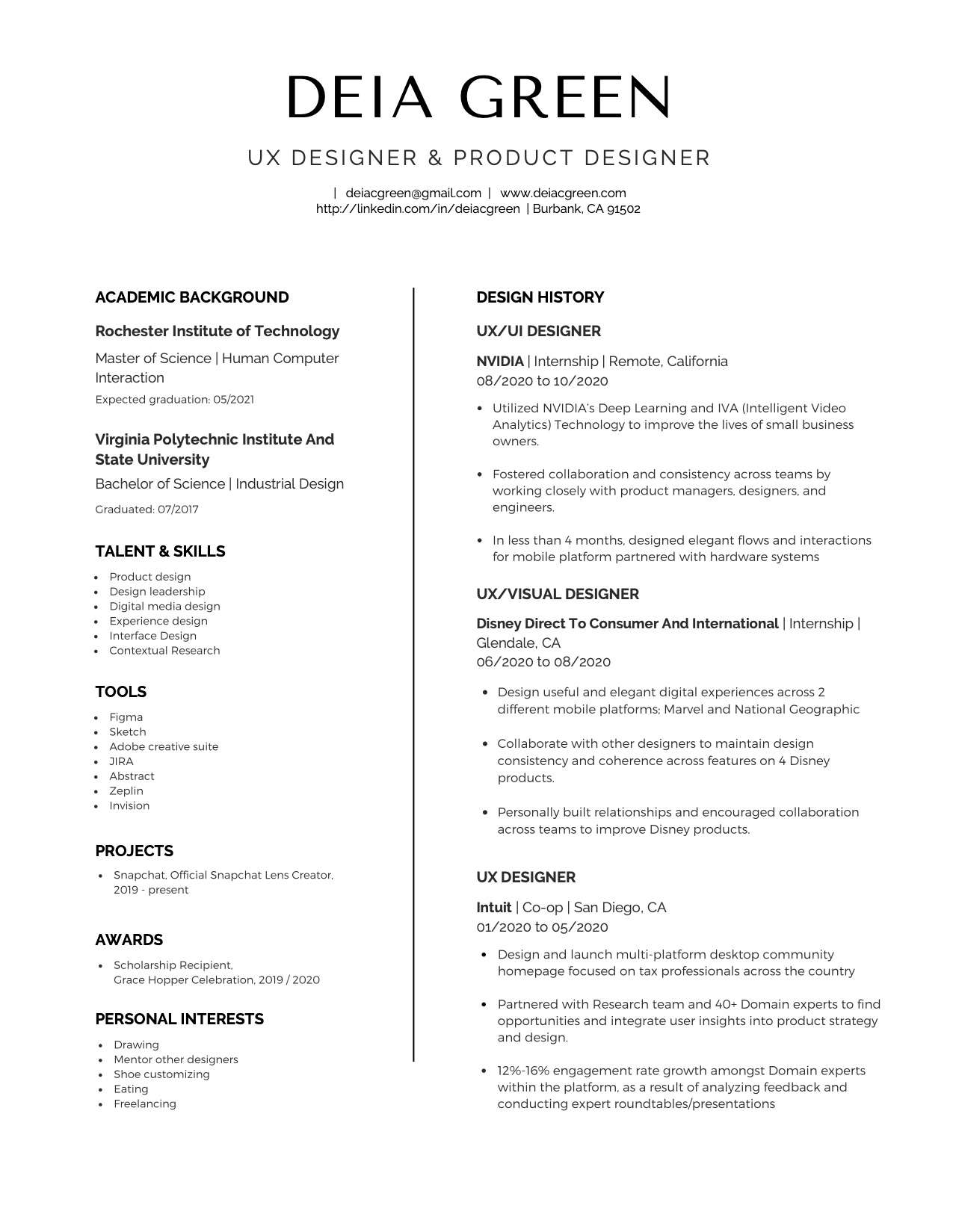
What you can learn:
As an intern, you might not have led teams, but you probably learned new skills and had an impact. Thinking about how your work impacted a product, team, or company can be a good starting point to decide what to emphasize.
3. UX designer
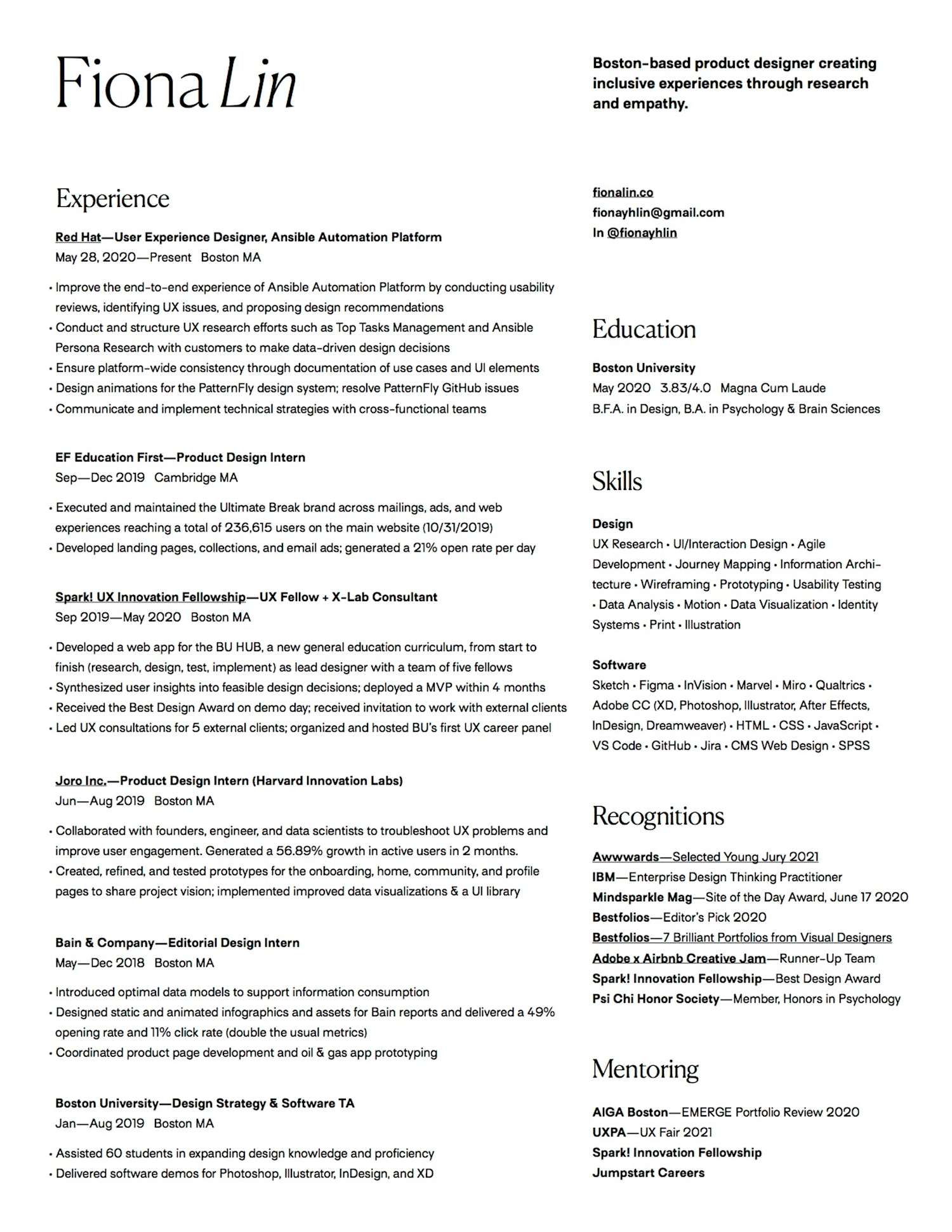
What you can learn:
Lists don’t always have to be lists. Finding creative ways to list information can save space for other relevant items.
Generally, it’s a good idea to organize jobs in chronological order to help hiring managers get a sense of your career progression. But if there’s something you want to emphasize before everything else, some exceptions can be made. A resume that prioritizes your skills and areas of expertise is called a “functional resume.”
4. Product designer
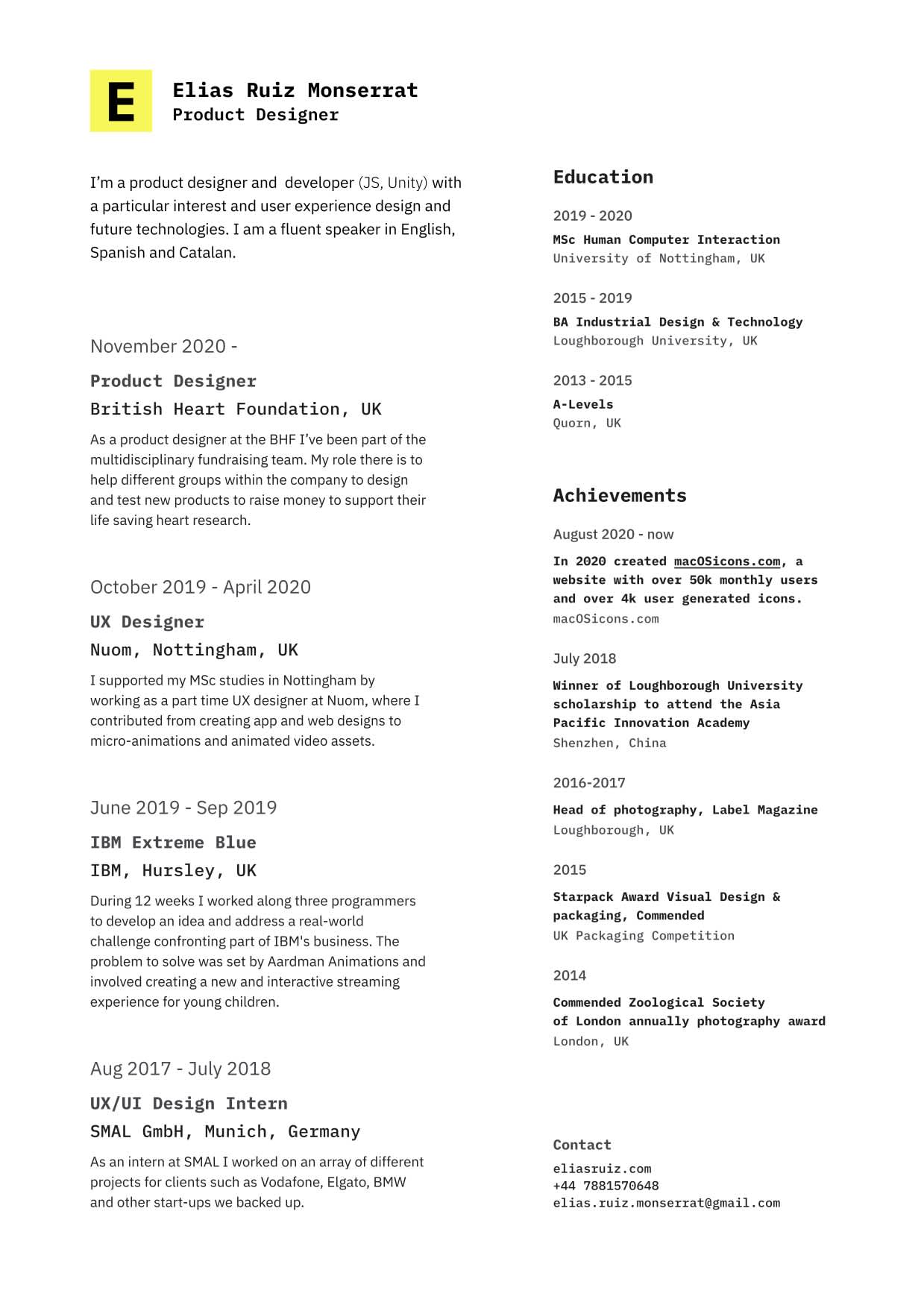
Courtesy of Elias Ruiz Monserrat
What you can learn:
You can describe your work experience in bullet-point lists or in short sentences. Choose the way that allows you to convey your work accomplishments most effectively.
Read more: 5 UX Designer Career Paths: Stepping Up Your Design Career
5. Senior UX designer

What you can learn:
Shaunak transitioned his career from a systems analyst to a UX designer. If you’ve changed careers, it can be useful to quickly reference what you were doing before, if you have space. This can give the recruiter a fuller picture of who you are and show that you might have some unique skills.
If you feel crunched for space, check to see if your resume has any excessive white space, or adjust your font sizes (though make sure it’s still easily readable). It’ll be a good idea to have somebody you trust look through your resume to catch any errors you might have overlooked.
Looking for step-by-step guidance? Try this hands-on course and you'll have crafted a strong resume by the end of this week:
6. Creative director, UX designer, and student
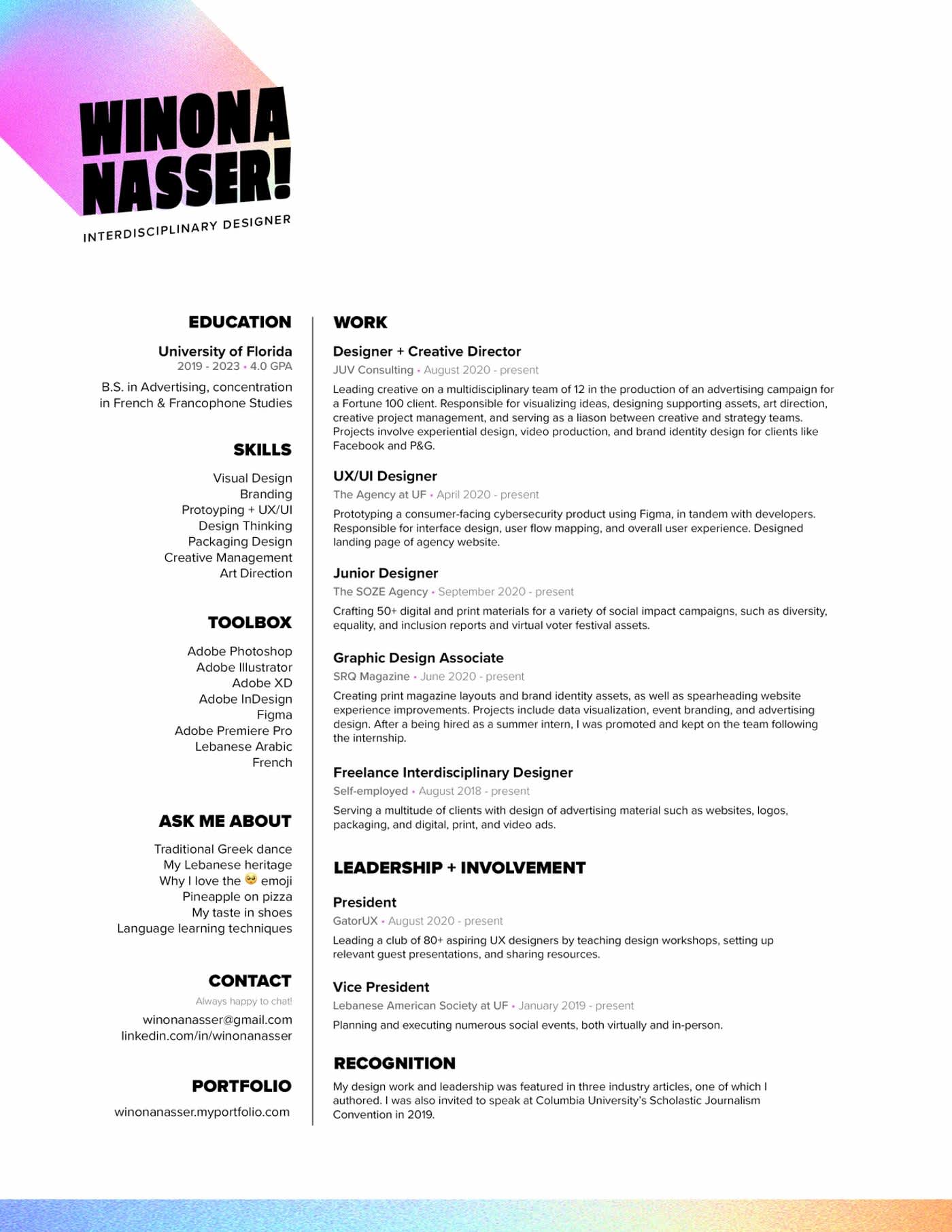
What you can learn:
If you have the space, you can include some facts about yourself outside of your design experience that can help humanize you or make you memorable to a recruiter.
7. Senior product designer
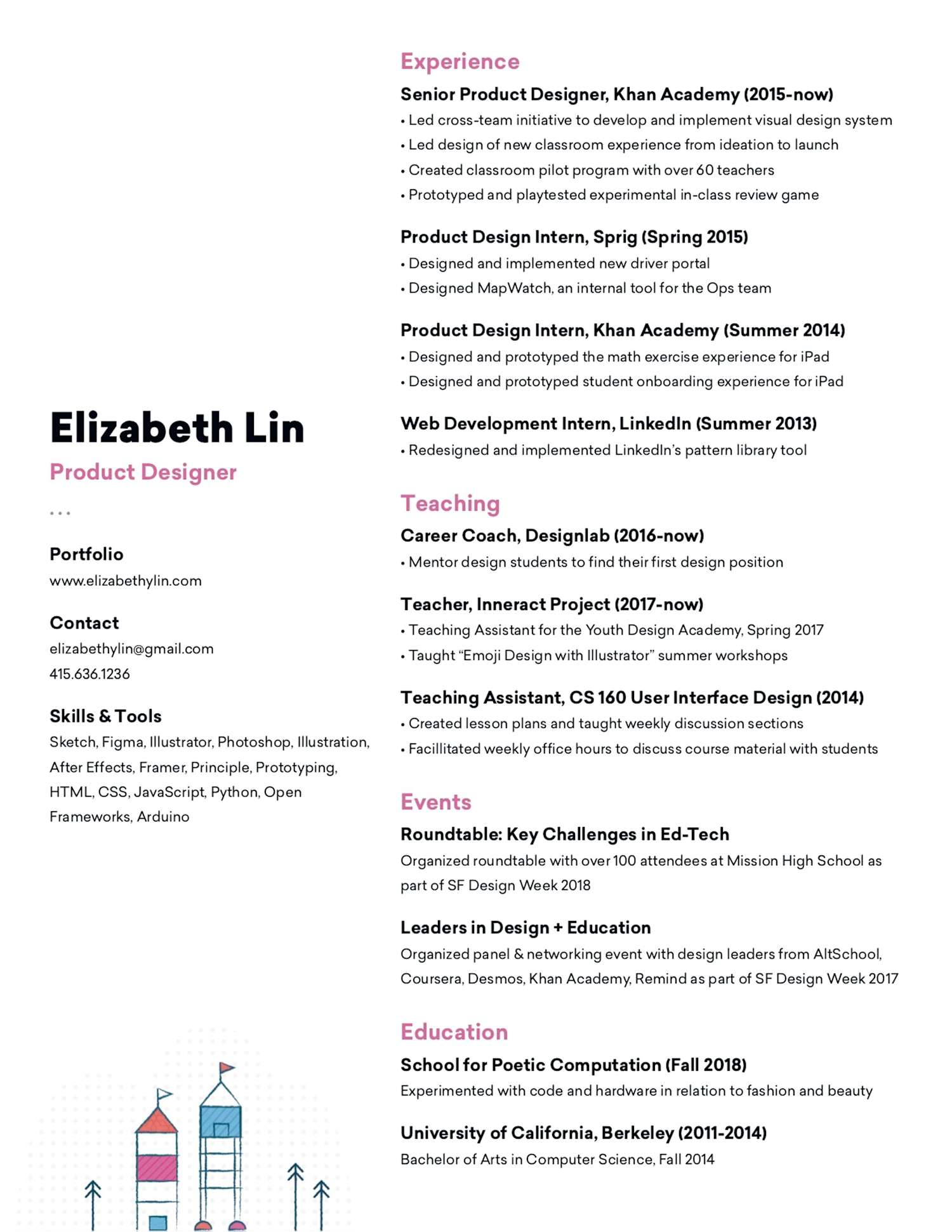
What you can learn:
Giving more room to your most relevant experiences can be a good idea. Keep in mind, this doesn’t always have to mean the most recent. Think about the job you’re applying to and choose the projects and skills that are most applicable.
Good use of whitespace and design elements can make a resume look clean and give it space to breathe. But remember to prioritize the content you want to include. If you’re dying to incorporate a fun design element but find it just won’t fit, don’t worry—you’ll have your portfolio to show off your creativity, too.
UX designer resume template
A blank page can be intimidating. Here’s a template you can use for inspiration.
We’ve kept it simple so you can customize your resume according to your tastes. Play around with fonts, add a dash of color, add another column, or rearrange any information to fit your needs. You may need to download the template and open it in a word processing program to make certain adjustments, like changing column widths.
The essentials
You’ll want to make sure you have the following items in your resume:
Name and contact information: Make sure you have your name, email address, link to a portfolio, and phone number listed somewhere easy to spot. You can also include your street address.
Portfolio: UX design resumes often include links to online portfolios that showcase a designer’s previous work. You’ll want to put this in a clearly visible place, like under your contact information. Here’s some guidance on putting together a UX designer portfolio.
Relevant experience: Your relevant experience should be listed in reverse chronological order, from most to least recent. Include the name of your employer, your title, applicable dates, and a short description of what you did and any significant achievements in a short paragraph or bullet point list.
Education: List your education history, including the name of your school, your degree (for example, Bachelor of Arts or Associate of Science), major, and years attended.
Skills: A separate list of skills can be helpful in design resumes because it allows hiring managers to quickly see what technical skills you have. List any tools you’re familiar with in this section. Learn what skills are in demand for UX designers.
What sets you apart: If you have the space, consider creating a section for achievements, recognitions, or even fun facts. If it won’t all fit on your resume, don’t worry—list what you think is essential and put the rest on your portfolio website.
What if I’ve never worked in UX design before?
Even if you haven't worked as a UX designer, chances are you have some skills and experiences lined up that are applicable to the job. These can be experiences you’ve had in related fields like graphic design or web development. They can also include roles where relevant soft skills—like collaboration, communication, or time management—played an important part.
If you’re starting from scratch or are looking to build up your hard skills in UX design, then consider enrolling in the Google UX Design Professional Certificate. You’ll learn how to conduct user research, use design tools like Figma and Adobe XD, and create your own portfolio.

Designing your best UX design resume
Readability should be a priority in your resume, but there are some elements you can play with.
Colors: Your inner designer might be tempted to experiment with color on your resume—pops of color can certainly make a resume interesting. But try to keep it simple, and save any major design efforts for your portfolio. Stick with black text to make it easy to read. Remember that there’s a chance your resume will be printed, so make sure any elements you put in color will still be legible if printed in black and white ink.
Typefaces: Choose a simple and clean font for your text. You can experiment with more interesting fonts for small elements like your name or certain headings, so long as they’re still clearly legible. Try bolding or italicizing headings, or information like dates, for visual variety.
PDF it: Using columns, colorful elements, or hard-to-find fonts can make for appealing resumes, but they increase the chance of formatting errors in a Microsoft Word doc. Saving and sending your resume as a PDF will make sure your recipient will see what you intended them to see.
What to avoid
Avoid these mistakes to ensure you’re in as competitive a position as you can be.
Typos and errors: Make sure to double-check for spelling and formatting errors. You’ll want to be sure the first impression you’re making is your best. Try having somebody you trust look through your resume for any errors you might have missed.
Multiple pages: Though it might be tempting to do otherwise, keep your resume to one page. Choose information that you think will be relevant to the job. Any information you can’t fit can go into your portfolio or website.
Explore free resources for UX designers
Interested in learning more about UX design? Gain new skills and stay up to date with the latest industry developments with free resources, such as our LinkedIn newsletter, Career Chat.
Watch on YouTube: Exploring In-Demand UX Designer Skills
Take the quiz: Which UX Course Should You Take? Find Out in 1 Minute
Master fundamental terminology: Glossary of UX Terms and Definitions
Whether you want to get comfortable with an in-demand technology or learn a new skill, you can keep growing with a Coursera Plus subscription, where you’ll get access to over 10,000 flexible courses.
Coursera Staff
Editorial Team
Coursera’s editorial team is comprised of highly experienced professional editors, writers, and fact...
This content has been made available for informational purposes only. Learners are advised to conduct additional research to ensure that courses and other credentials pursued meet their personal, professional, and financial goals.